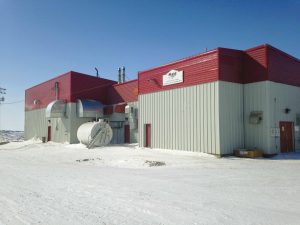
Pangnirtung Wastewater Treatment Plant, Nunavut
August 24, 2016
By Daryl Burke, P.Eng. and Ed Bowes, exp
The addition of an MBR system to the sewage treatment plant of a hamlet in Canada’s High Arctic helps to preserve the pristine environment.
From the June-July 2016 print issue, page 18.

Expanded wastewater treatment plant building, Pangnirtung, Nunavut. Photo: exp
In 2012 the Government of Nunavut engaged exp to investigate options for upgrading the underperforming Pangnirtung Wastewater Treatment Facility. Its existing biomechanical treatment process was not meeting the environmental discharge limits, causing major problems for the community.
Pangnirtung is an Inuit hamlet of approximately 1,500 people on Baffin Island. It is located part way up the Pangnirtung Fjord, surrounded by steep, rocky cliffs and rugged terrain. Travel to the community must be either by air or by sea.
The plant’s receiving water comes from the fjord, which connects with the Cumberland Sound. The fjord sustains a vibrant fishing industry upon which many of the hamlet’s residents depend for their livelihood.
Existing plant severely undersized
Exp completed a thorough review of the plant process and concluded that it was severely undersized. The available design information for the previous facility did not clearly identify the rated capacity for the process, but the extremely poor effluent quality and review of the biological process volumes made it clear the system could not handle the required flow and loading conditions.
The plant needed a significant upgrade. Based on pre-design work completed by exp, the design capacity for the upgraded facility was set at 290 m3/d.
Extremely demanding environment
The exp team had a formidable task. Construction in Canada’s High Arctic is extremely demanding; fickle weather conditions and isolation can plague the success of a project. Winter temperatures in the remote Baffin Island community can go as low as -50°C with the wind chill. There are limited opportunities to ship in materials and equipment, and the construction season is short, sometimes constrained to three or four months for outdoor work. Communications can be intermittent, which further adds to the project challenges.
Exp ultimately recommended that the plant should be upgraded with a compact, high-performance membrane bioreactor (MBR) treatment system. The system provides effluent of high quality to protect the pristine receiving water and it reduces the overall footprint. A reduced footprint for the upgrade was critical as all the equipment needed to be housed in a heated building to prevent freezing.
New membrane tanks, which had to fit within the existing space to minimize the need to expand the building, were designed with side-opening doors to allow the membrane modules to be installed and removed. The low ceiling height in the existing building would have prevented the membrane modules being extracted through the top of the tanks.
The system was also provided with a passive sludge dewatering system using geomembrane filter bags loaded onto a hydraulically activated dump trailer.
The completed design repurposed all of the existing building space and included an addition to the building structure and thermosiphon system to accommodate new process equipment and tanks.
Complete design package
Exp provided a complete design package, including process piping and equipment, controls, mechanical, electrical services and the building HVAC. We also provided follow-up services throughout the design to assist with problem solving and troubleshooting of the existing process and building mechanical equipment, work which was not included in the original project scope. Architectural, structural, and geotechnical services were also provided.
The MBR system is capable of far exceeding the effluent discharge limits and outputting the highest quality of effluent to the local receiving water. On most days the operators are producing an effluent TSS (total suspended solids) concentration at or close to 0 mg/L and BOD (biochemical oxygen demand) concentrations less than 10 mg/L. It can remove greater than 99% of TSS and 98% of BOD.
The project cost was $10,500,000 including equipment purchase, engineering, construction, start-up and commissioning services. Despite the challenging conditions, a solution was designed and implemented for the community that respects the triple bottom line — the environmental, the social, and the financial.
Project: Pangnirtung Wastewater Treatment Facility Upgrade
Client/owner: Government of Nunavut
Prime consultant: exp, Ottawa and Fredericton (Stephen Burden, P.Eng., Stephen Bliss, M.Sc.E. , P.Eng., Daryl Burke, P.Eng., Mark McCormick, P.Eng., Robert MacQuarrie, P.Eng.)